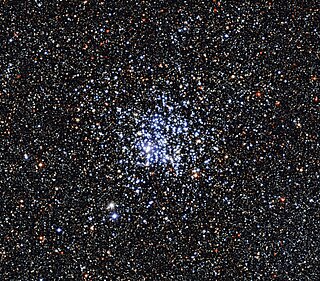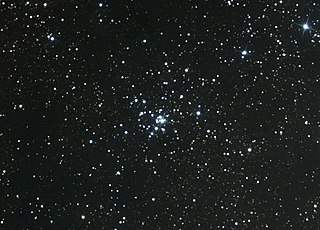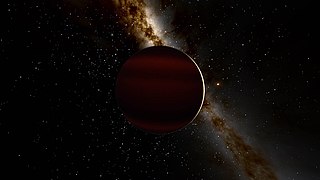Related Research Articles

A satellite or artificial satellite is an object, typically a spacecraft, placed into orbit around a celestial body. Satellites have a variety of uses, including communication relay, weather forecasting, navigation (GPS), broadcasting, scientific research, and Earth observation. Additional military uses are reconnaissance, early warning, signals intelligence and, potentially, weapon delivery. Other satellites include the final rocket stages that place satellites in orbit and formerly useful satellites that later become defunct.

The Space Telescope Science Institute (STScI) is the science operations center for the Hubble Space Telescope (HST), science operations and mission operations center for the James Webb Space Telescope (JWST), and science operations center for the Nancy Grace Roman Space Telescope. STScI was established in 1981 as a community-based science center that is operated for NASA by the Association of Universities for Research in Astronomy (AURA). STScI's offices are located on the Johns Hopkins University Homewood Campus and in the Rotunda building in Baltimore, Maryland.

The Goddard Space Flight Center (GSFC) is a major NASA space research laboratory located approximately 6.5 miles (10.5 km) northeast of Washington, D.C. in Greenbelt, Maryland, United States. Established on May 1, 1959 as NASA's first space flight center, GSFC employs about 10,000 civil servants and contractors. Named for American rocket propulsion pioneer Robert H. Goddard, it is one of ten major NASA field centers. GSFC is partially within the former Goddard census-designated place; it has a Greenbelt mailing address.
Observational cosmology is the study of the structure, the evolution and the origin of the universe through observation, using instruments such as telescopes and cosmic ray detectors.
In physical cosmology, the age of the universe is the time elapsed since the Big Bang. Astronomers have derived two different measurements of the age of the universe: a measurement based on direct observations of an early state of the universe, which indicate an age of 13.787±0.020 billion years as interpreted with the Lambda-CDM concordance model as of 2021; and a measurement based on the observations of the local, modern universe, which suggest a younger age. The uncertainty of the first kind of measurement has been narrowed down to 20 million years, based on a number of studies that all show similar figures for the age. These studies include researches of the microwave background radiation by the Planck spacecraft, the Wilkinson Microwave Anisotropy Probe and other space probes. Measurements of the cosmic background radiation give the cooling time of the universe since the Big Bang, and measurements of the expansion rate of the universe can be used to calculate its approximate age by extrapolating backwards in time. The range of the estimate is also within the range of the estimate for the oldest observed star in the universe.

The Wild Duck Cluster is an open cluster of stars in the constellation Scutum. It was discovered by Gottfried Kirch in 1681. Charles Messier included it in his catalogue of diffuse objects in 1764. Its popular name derives from the brighter stars forming a triangle which could resemble a flying flock of ducks. The cluster is located just to the east of the Scutum Star Cloud midpoint.

Messier 21 or M21, also designated NGC 6531 or Webb's Cross, is an open cluster of stars located to the north-east of Sagittarius in the night sky, close to the Messier objects M20 to M25. It was discovered and catalogued by Charles Messier on June 5, 1764. This cluster is relatively young and tightly packed. A few blue giant stars have been identified in the cluster, but Messier 21 is composed mainly of small dim stars. With a magnitude of 6.5, M21 is not visible to the naked eye; however, with the smallest binoculars it can be easily spotted on a dark night. The cluster is positioned near the Trifid nebula, but is not associated with that nebulosity. It forms part of the Sagittarius OB1 association.

Planck was a space observatory operated by the European Space Agency (ESA) from 2009 to 2013. It was an ambitious project that aimed to map the anisotropies of the cosmic microwave background (CMB) at microwave and infrared frequencies, with high sensitivity and small angular resolution. The mission was highly successful and substantially improved upon observations made by the NASA Wilkinson Microwave Anisotropy Probe (WMAP).

Citizen science is research conducted with participation from the general public, or amateur/nonprofessional researchers or participants for science, social science and many other disciplines. There are variations in the exact definition of citizen science, with different individuals and organizations having their own specific interpretations of what citizen science encompasses. Citizen science is used in a wide range of areas of study including ecology, biology and conservation, health and medical research, astronomy, media and communications and information science.
The Cornell Lab of Ornithology is a member-supported unit of Cornell University in Ithaca, New York, which studies birds and other wildlife. It is housed in the Imogene Powers Johnson Center for Birds and Biodiversity in Sapsucker Woods Sanctuary. Approximately 250 scientists, professors, staff, and students work in a variety of programs devoted to the Lab's mission: interpreting and conserving the Earth's biological diversity through research, education, and citizen science focused on birds. Work at the Lab is supported primarily by its 75,000 members.

TW Hydrae is a T Tauri star approximately 196 light-years away in the constellation of Hydra. TW Hydrae is about 80% of the mass of the Sun, but is only about 5-10 million years old. The star appears to be accreting from a face-on protoplanetary disk of dust and gas, which has been resolved in images from the ALMA observatory. TW Hydrae is accompanied by about twenty other low-mass stars with similar ages and spatial motions, comprising the "TW Hydrae association" or TWA, one of the closest regions of recent "fossil" star-formation to the Sun.

Archeops was a balloon-borne instrument dedicated to measuring the Cosmic microwave background (CMB) temperature anisotropies. The study of this radiation is essential to obtain precise information on the evolution of the Universe: density, Hubble constant, age of the Universe, etc. To achieve this goal, measurements were done with devices cooled down at 100mK temperature placed at the focus of a warm telescope. To avoid atmospheric disturbance the whole apparatus is placed on a gondola below a helium balloon that reaches 40 km altitude.
In biology, determination is the process of matching a specimen of an organism to a known taxon, for example identifying a plant. The term is also used in cellular biology, where it means the act of the differentiation of stem cells becoming fixed. Various methods are used, for example single or multi-access identification keys.
The Atlas of Living Australia (ALA) is an online repository of information about Australian plants, animals, and fungi. Development started in 2006. The Commonwealth Scientific and Industrial Research Organisation (CSIRO) is an organisation significantly involved in the development of the ALA. The Atlas of Living Australia is the Australian node of the Global Biodiversity Information Facility. The ALA is being used to help assess suitability of revegetation projects by determining species vulnerability to climatic and atmospheric change.

Coastal Observation and Seabird Survey Team (COASST) is a citizen science project of the University of Washington, Seattle, Washington, US, with a goal of monitoring marine ecosystem health with the support of citizens within coastal communities. With the help of hundreds of volunteers, COASST assesses beach conditions and identifies and tracks any carcasses of dead seabirds found. Data on the carcass of a seabird contributes to the creation of a baseline record for the death rates of various species of seabirds, including which beaches birds are found at and in what density. Any irregularities can be identified and evaluated, so the cause of any increased mortality can be identified. COASST works with state, tribal, and federal agencies, environmental organizations, and community groups to help achieve their goals of monitoring and successfully establishing marine conservation solutions.
SciStarter recruits, trains, and equips people for citizen science research projects in need of their help. It was founded by Darlene Cavalier and is a research affiliate of Arizona State University's School for the Future of Innovation in Society. SciStarter is a collection of smart web tools and an event-based organization that connects people to more than 1,200 registered and vetted citizen science projects, events, and tools. New tools, developed by SciStarter with support from the National Science Foundation, enable citizen scientists to find, join, and track their contributions across projects and platforms. The organization's primary goal is to break down barriers preventing non-scientists from fully engaging in scientific research.

NGC 2865 is an isolated elliptical galaxy in the equatorial constellation of Hydra. The core region of the galaxy shows a kinematically distinct component showing indications of a recent accretion or merger event that led to a burst of star formation around the nucleus. Observational constraints require this to have occurred within the last 100–400 million years, with the merger most likely being an Sb or Sc-class spiral galaxy.

WISE 2150–7520 AB is a binary brown dwarf 78.9 light-years distant from Earth in the southern constellation Octans. The system is a wide binary with a separation of 341 astronomical units. The primary of the system was discovered in 2005 as an infrared object with high proper motion and in 2008 was found to be an ultracool dwarf with a spectral type of L. The secondary, a much cooler T dwarf, was discovered by volunteers of the citizen science project Backyard Worlds: Planet 9, using data from the Wide-field Infrared Survey Explorer (WISE). The system was followed up by the project scientists with Magellan and Spitzer and a scientific paper describing the binary was published in the Astrophysical Journal in 2020.

Craspedotropis gretathunbergae is a species of snail in the family Cyclophoridae. The species was discovered in Brunei by a team of citizen scientists and subsequently named after climate activist Greta Thunberg.

MERMOZ is an astrobiology project designed to remotely detect biosignatures of life. Detection is based on molecular homochirality, a characteristic property of the biochemicals of life. The aim of the project is to remotely identify and characterize life on the planet Earth from space, and to extend this technology to other solar system bodies and exoplanets. The project began in 2018, and is a collaboration of the University of Bern, University of Leiden and Delft University of Technology.
References
- ↑ Mapes, Lynda V. (February 16, 2013). "Citizen scientists can be climate sleuths too". Seattle Times. Retrieved 18 February 2013.
- ↑ Robbins, Jim (August 19, 2013). "Crowdsourcing, for the birds". New York Times. Retrieved 20 May 2014.
- ↑ "Update: EyeWire". Scientific American. Retrieved 18 February 2013.
- ↑ Schilthuizen, Menno; Seip, Lilian; Otani, Sean; Suhaimi, Jadda; Njunjić, Iva (2017-06-12). "Three new minute leaf litter beetles discovered by citizen scientists in Maliau Basin, Malaysian Borneo (Coleoptera: Leiodidae, Chrysomelidae)". Biodiversity Data Journal. 5 (5): e21947. doi: 10.3897/bdj.5.e21947 . ISSN 1314-2828. PMC 5740419 . PMID 29308046.
- ↑ "National Monitoring Network of the National Water Quality Monitoring Council".
- ↑ "TurtleSAT Community Program > Home".
- ↑ "iTech Explorers". SciStarter. Retrieved 2020-02-06.
- ↑ "AgeGuess". SciStarter. Retrieved 2020-02-06.
- ↑ "old Weather". Zooniverse. Retrieved 10 January 2015.
- ↑ Kruk, Sandor; Martín, Pablo García; Popescu, Marcel; Merín, Bruno; Mahlke, Max; Carry, Benoît; Thomson, Ross; Karadağ, Samet; Durán, Javier; Racero, Elena; Giordano, Fabrizio; Baines, Deborah; Marchi, Guido de; Laureijs, René (2022-05-01). "Hubble Asteroid Hunter - I. Identifying asteroid trails in Hubble Space Telescope images". Astronomy & Astrophysics. 661: A85. arXiv: 2202.00246 . doi:10.1051/0004-6361/202142998. ISSN 0004-6361. S2CID 241469611.
- ↑ Wilson, John-James; Jisming-See, Shi-Wei; Brandon-Mong, Guo-Jie; Lim, Aik-Hean; Lim, Voon-Ching; Lee, Ping-Shin; Sing, Kong-Wah (2015-11-12). "Citizen Science: The First Peninsular Malaysia Butterfly Count". Biodiversity Data Journal. 3 (3): e7159. doi: 10.3897/BDJ.3.e7159 . ISSN 1314-2828. PMC 4700385 . PMID 26751033.
- ↑ Thompson, Nicole (27 Aug 2015). "McMaster crowd-sources archival postcard project". Hamilton Spectator. Retrieved 27 Aug 2015.